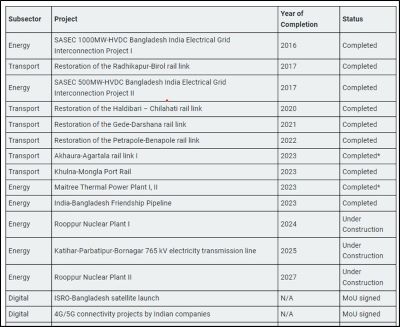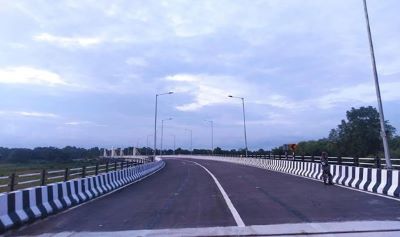Context-
As Bangladesh navigates an unprecedented political transition, the future of its development trajectory has become increasingly uncertain. The sudden departure of former Prime Minister Sheikh Hasina on August 5, 2024, has raised critical questions about the continuity of various connectivity projects essential for strengthening India-Bangladesh relations. India emerged as Bangladesh's most vital development partner, with a portfolio worth approximately US$ 8 billion, encompassing crucial bilateral and regional connectivity initiatives. As the interim government led by Mohammad Yunus seeks to restore normalcy, understanding the fate of these connectivity projects is essential.
● Geographic and Economic Context
The India-Bangladesh partnership is anchored in geographic proximity and interlinkages, making connectivity cooperation a cornerstone of bilateral relations. With the world’s fifth-longest border, measuring 4,096 kilometers, Bangladesh shares extensive boundaries with India’s northeastern states and West Bengal. This unique positioning makes robust connectivity with India imperative for Bangladesh, which is often described as “India locked.” For India, enhancing connectivity with Bangladesh is critical as it opens access to the Bay of Bengal, significantly boosting maritime trade opportunities.
Additionally, Bangladesh is integral to India’s “Neighbourhood First” and “Act East” policies, emphasizing its role as an eastern neighbor and a land bridge to Southeast Asia. The trade ties between the two nations are also robust, with India being Bangladesh’s largest trading partner. The range of traded goods includes energy, food, textiles, electric appliances, and plastics, necessitating multiple connectivity channels such as rail links, bus routes, inland waterways, and seaports.
● Comprehensive Connectivity Approach
India and Bangladesh have increasingly defined connectivity to encompass more than just physical linkages. The recent joint statement issued during Hasina’s last visit to India in June 2024 highlighted collaborative projects across energy, transport, and digital sectors. Given the current political scenario, where the fate of these projects remains ambiguous, it is crucial to revisit these initiatives and assess their merits.
Table: Status of India’s Connectivity Projects with Bangladesh

Physical Connectivity Initiatives
● Vision for Regional Integration
India and Bangladesh share a vision of utilizing their extensive bilateral cooperation as a foundation for regional and sub-regional integration within the Global South. Platforms such as the Bay of Bengal Initiative for Multi-Sectoral Technical and Economic Cooperation (BIMSTEC) and the South Asian Association for Regional Cooperation (SAARC) play significant roles in this context. One of the key initiatives prioritized was the operationalization of the Bangladesh-Bhutan-India-Nepal (BBIN) Motor Vehicle Agreement, aimed at enhancing sub-regional connectivity.
● Expanding Rail and Road Networks
To further enhance transport connectivity, an MoU on Railway Connectivity was signed to initiate goods train services between Gede (India) and Darshana (Bangladesh), extending towards Haldibari and Hasimara. This project not only facilitates trade between India and Bangladesh but also serves as a transit route for Bhutan, with potential benefits extending to Nepal. Although the framework exists, actual implementation and passenger services remain pending.
Energy Connectivity Initiatives
Energy cooperation has been another cornerstone of India-Bangladesh relations. Significant initiatives include the India-Bangladesh Friendship Pipeline, which lowers diesel supply costs and alleviates power shortages in Bangladesh. The jointly developed Maitree Thermal Power Plant is also pivotal for boosting the energy supply.
Additionally, India’s collaboration in constructing Bangladesh’s first nuclear power plant at Rooppur signifies a substantial step forward. This partnership paves the way for Bangladesh’s entry into the nuclear energy arena, promoting energy security and sustainability.
● Upcoming Energy Infrastructure
Plans to expedite the construction of a 765 kV high-capacity electricity transmission line between Katihar (India), Parbatipur (Nepal), and Bornagar (Bangladesh) were set to be part of a groundbreaking tripartite power trade agreement. However, the fate of this agreement remains unclear amidst the political transition in Bangladesh.
Digital Connectivity Initiatives
● Digital Partnership Objectives
In her last visit to India, former PM Hasina and Indian Prime Minister Narendra Modi signed multiple MoUs aimed at establishing an India-Bangladesh Digital Partnership. This partnership seeks to leverage digital technologies to foster economic growth, enhance cross-border digital interchange, and promote regional prosperity. The collaboration is particularly aligned with Bangladesh’s 2041 Smart Bangladesh plan, targeting smart citizens, smart government, smart economy, and smart society.
Initial projects focus on digitizing cross-border BBIN-MVA licenses and rolling out 4G/5G networks through Indian companies like Bharti Airtel and Jio Infocomm.
Impacts of Political Transition
● Immediate Consequences of the Political Shift
Following the coup in Bangladesh, India temporarily closed its six major land ports and reinforced border security, suspending rail connectivity indefinitely. However, trade was quickly normalized with the reopening of the Petrapole-Benapole land port, highlighting the resilience of economic interdependence.
This swift restoration of trade underscores the significance of existing economic and infrastructure linkages. It exemplifies New Delhi’s long-term strategy to cultivate economic dependencies and enhance regional stability through connectivity projects.
The political transition presents both challenges and opportunities for India-Bangladesh relations. The interim government’s cautious approach to utilizing India’s extended credit lines could hinder Bangladesh’s long-term development prospects. It is crucial for New Delhi to maintain ongoing projects while also seeking new avenues for cooperation.
India’s regional role demands continuous engagement and proactive strategies. The connectivity projects between India and Bangladesh play a vital role in not only fostering bilateral relations but also in supporting broader regional development. As Bangladesh aspires to attain developing country status by 2026, maintaining robust cooperation with India will be critical.
The future of India-Bangladesh ties hinges on both nations’ ability to adapt to changing political landscapes while prioritizing economic collaboration. Sectors like renewable energy, digital infrastructure, and climate resilience present promising areas for growth. Ultimately, the commitment to sustained bilateral cooperation is essential for navigating the complexities of South Asia’s geopolitical environment.
|
Probable Question for UPSC Mains Exam- 1. Discuss the impact of political transitions in Bangladesh on the continuity and future of India-Bangladesh connectivity projects, particularly in the sectors of energy and digital infrastructure. (10 Marks,150 Words) 2. Analyse how the geographical and economic interdependencies between India and Bangladesh shape their bilateral relations and influence regional stability in South Asia. (15 Marks, 250 Words) |







